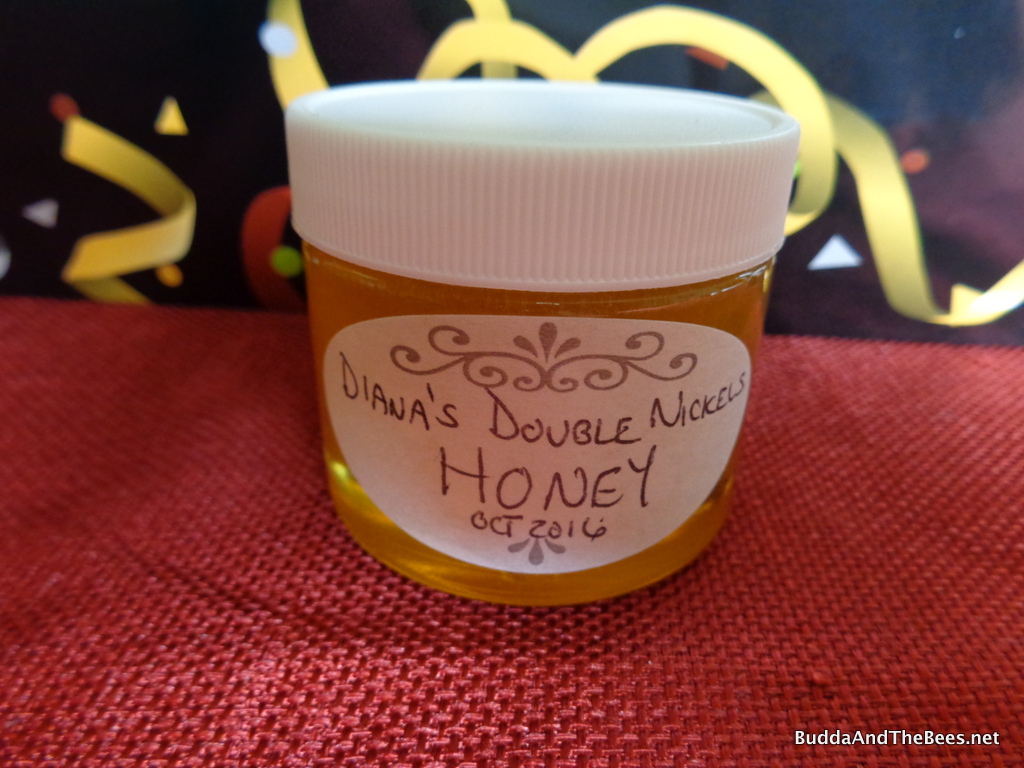We’ve had a beautiful summer with no long stretches of extremely hot weather but we’ve some impressive downpours. This past week, we got over an inch of rain in less than an hour. As Diana says, it’s been more like a Montana summer than a Colorado one. The gardens have been flourishing from all the moisture. But I feel fall in the air – the mornings are getting darker when I wake up. Also, Patrick has to go back to school next week so he’s cranky – another sure sign of fall.
One would think with all the flowers in bloom this year, there would be a bumper crop of honey. When I looked in the hives in mid July, there were a few new combs being built at the back, so I figured they were getting ready for expanding and filling them up with honey.
I moved the little guy above in between two bigger combs so they would build it straight and have been monitoring progress in both hives through the windows. Unfortunately, they’ve stopped building any new comb, and they have have not made much more honey. The late summer dearth is in full swing.
Last week, I looked in BnB1 to see if they were capping any of the honey they had. I had planned on harvesting the 2 bars that they welded together, but since they had stopped making any more comb, I want to make sure they have enough honey to last them through the winter. I was nicely surprised that they had 4 good solid combs of capped honey and lots of fresh nectar in the brood area. Still not sure if I’ll take any honey this fall – might wait until spring.
This week, it was BnB2’s turn. Aided by my lovely assistant:
we looked through the whole hive. I hadn’t seen the queen since May, but there has always been good brood, so I knew she was in there. Turns out, she’s been hiding from us on these inspections (as they are wont to do) – we found her on the last bar we checked at the very front of the hive. She looked good so I won’t bother her any more this year. Didn’t get a picture of her because the smoker ran out and the bees were getting a bit pissy. One crawled up my leg and stung me and they really got riled when I did my “ouch,ouch,ouch” dance. As I told Diana later, I should have just kept working – it wasn’t like she was going to sting me again – she was already dead. I’m trying the toothpaste remedy for the sting – not sure I’m convinced it works better than ice.
They don’t have any full bars of honey like BnB1 (which concerns me a bit), but in the brood area, they have good bands of capped honey. Like Julie’s hives, I think this one has been more intent on making bees instead of making honey.
There is lots of new brood – both capped and uncapped. There weren’t many drones and no new drone brood – it’s getting time for them to kick the drones out of the hive. I still haven’t seen a new egg – I need to bring my computer glasses home one weekend because I just can’t see up close with my regular progressive lenses. The drawbacks of getting older.
Our Rose of Sharon bushes are are in full bloom and I love watching the bees on these flowers. The flowers are loaded with pollen and the bees get so coated in it, they sometimes have trouble flying.
I also love watching the different kinds of bees and pollinators that are attracted to these – honeybees, bumblebees, native bees, wasps, and hummingbirds.
We saw our first monarch butterfly this past week on, of all things, a butterfly bush. We’ve had goldfinches cleaning up the sunflowers – I love watching them and listening to their happy chirping. We’ve only had a few hummingbirds this year but there are lots of them in the higher elevations according to my friends who live up there. If you stop using pesticides and let the flowers flourish, you end up with a more diverse and interesting ecosystem.
I don’t think we get a late summer honey flow here in Colorado. They just mowed all the alfalfa that was in bloom which might have been the only hope. We don’t have a big goldenrod bloom like they do back East which I guess is in full swing. I feel sorry for anyone who suffers from allergies.
So, it may be that what I see now is what I get, so I’ll just have to wait and see.








2 Comments
Julie · August 18, 2014 at 7:00 am
Great photos. What a sweet caption for your wife’s picture, too!
Very interesting about the rose of sharon, too. I’ve been looking for bee-friendly shrubs that bloom this time of year. Thanks for that tip!
Don · August 18, 2014 at 2:11 pm
She thought it was kinda dorky. 😉 Even before I started keeping bees, I’d sit and watch them on the Rose of Sharon getting coated with pollen and then try to fly with all that extra weight. The plants I have were here when I moved in and they are pretty self reliant, so I hope that works out for you too.